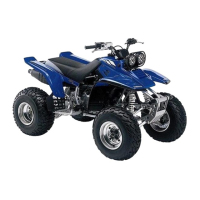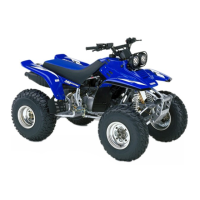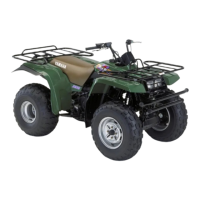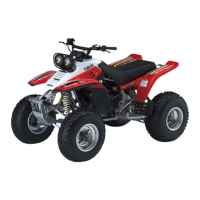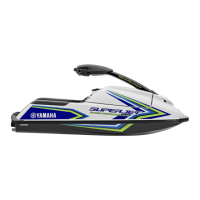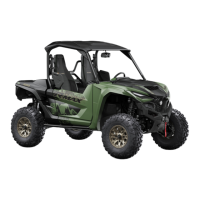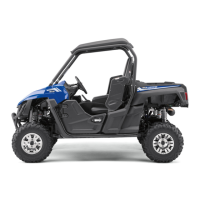Do you have a question about the Yamaha WARRIOR YFM350X and is the answer not in the manual?
Identifies key parts like Seat, Levers, Switches, Wheels, and Fuel System.
Explains the ON and OFF positions of the main switch for starting the engine and electrical circuits.
Explains the function of the Reverse and Neutral indicator lights.
Details the Engine Stop and Start switches for controlling engine operation.
Describes how to use the LO, HI, and OFF positions for headlights and taillights.
Explains throttle control for engine speed and warns about malfunctions.
Details the speed limiter function and warnings about improper adjustment.
Explains how to engage and disengage the clutch for smooth operation.
Describes how to apply the front brake by pulling the lever.
Explains how to apply the rear brake by pushing down the pedal.
Details how to use the parking brake and its limitations on engine speed.
Explains the 6-speed transmission and shift pedal usage.
Describes using the drive select lever for forward and reverse motion.
Instructions on how to remove the fuel tank cap.
Explains the OFF, ON, and RES positions of the fuel cock.
Details how to use the starter for cold engine starting.
Instructions on how to remove and install the seat.
Explains how to adjust spring preload for rider weight and conditions.
Details adjusting spring preload and damping force for the rear shock absorber.
Checks brake operation, free play, fluid level, and leaks.
Ensures sufficient gasoline and specifies recommended fuel type and tank capacity.
Checks engine oil level and specifies recommended oil type and classification.
Guides on checking chain condition, slack, and lubrication.
Ensures the throttle lever operates smoothly and returns to idle.
Verifies tightness of all chassis fittings and fasteners before riding.
Checks headlight and taillight for proper working condition.
Checks operation of headlight, engine stop, and other switches.
Checks battery fluid level and terminal tightness, adds distilled water if needed.
Emphasizes using recommended tires and proper inflation for safe operation.
Details recommended, minimum, and maximum tire pressures and seating procedures.
Explains how to use the low-pressure tire gauge and set cold tire pressures.
Specifies when to replace tires based on tread groove depth.
Emphasizes reading the manual to understand controls and avoid accidents.
Provides step-by-step instructions for starting a cold engine safely.
Refers to cold start procedure and specifies not to use starter or accelerate hard.
Explains the importance of warming up the engine for longevity and performance.
Details how to operate the drive select lever for forward and reverse, including safety precautions.
Explains the 6-speed transmission and proper shifting procedures with clutch usage.
Provides steps for starting from a stop and accelerating, emphasizing throttle and clutch coordination.
Guides on slowing down, stopping, and downshifting, highlighting brake and shifting safety.
Details the critical 0-20 hour period for engine wear-in and avoiding excessive load.
Instructs on stopping the engine, shifting to neutral, and applying the parking brake.
Provides safety precautions for parking on hills, including gear selection and wheel blocking.
Advises choosing genuine or equivalent accessories and mounting them securely.
Guidelines for carrying cargo or towing trailers, emphasizing weight limits and secure attachment.
Stresses the need for training, familiarization, and skill development for safe operation.
Warns against operation by children under 16, especially with engines over 90cc.
States the ATV is for operator only and warns against carrying passengers due to balance issues.
Lists essential protective gear including helmet, eye protection, gloves, boots, and clothing.
Warns against operating the ATV under the influence of alcohol or drugs due to impaired performance.
Emphasizes performing pre-operation checks from page 5-1 for safety and proper care.
Stresses using correct tires and maintaining proper inflation pressure for safe operation.
Advises riding at appropriate speeds based on terrain, visibility, and rider experience.
Explains the speed limiter's role in controlling power and top speed.
Advises caution when riding with extra loads, as handling may be affected.
Emphasizes keeping feet on footboards and hands on handlebars for control.
Warns against performing stunts like wheelies or jumps due to risk of losing control or overturning.
Strictly prohibits riding on public roads, streets, or highways due to illegality and collision risks.
Advises riding cautiously in unfamiliar areas and staying alert to terrain hazards.
Warns against riding on difficult terrain until skills are developed, emphasizing extra care.
Recommends using caution flags in low-visibility areas and not using flag pole bracket as trailer hitch.
Advises respecting "no trespassing" signs and obtaining permission for private property riding.
Recommends practicing basic skills in a large, flat, obstacle-free off-road area.
Guides on preparing to ride, including starting the engine and checking for hot components.
Details starting in 1st gear, accelerating, and shifting to higher gears, emphasizing throttle/clutch coordination.
Advises following proper turning procedures, practicing at low speeds, and avoiding excessive speed.
Details weight transfer and body lean for turning, and practicing in safe areas.
Warns against operating on overly steep hills, as the vehicle can overturn more easily.
Explains the importance of transferring weight forward when climbing hills for balance and control.
Guides on how to react if the ATV starts to tip, including dismounting safely.
Offers solutions for when the ATV fails to turn, involving stopping and practicing maneuvers.
Provides steps to regain balance and avoid overturning when the ATV starts to tip.
Advises steering in the direction of the slide to regain control, avoiding braking or accelerating.
Lists items for initial and periodic checks/lubrication for valves, spark plug, filters, etc.
Details how to check engine oil level and specifies recommended oil types and quantities.
Provides step-by-step instructions for changing engine oil and cleaning the oil filter.
Explains how to inspect the spark plug, its condition, and when to replace it.
Guides on cleaning the air filter element, case, and check hose, with warnings about solvents.
Advises leaving most adjustments to dealers, but mentions idle speed can be owner-adjusted.
Details how to adjust engine idling speed using a tachometer and the throttle stop screw.
States that valve clearance changes with use and should be adjusted by a professional technician.
Explains how to adjust throttle lever free play after setting idle speed.
Guides on checking brake pad wear using indicators and when to replace them.
Details how to check brake fluid level, precautions, and recommended fluid type (DOT 4).
States that complete fluid replacement should be done by trained personnel and lists components for replacement.
Explains how to adjust the free play of the front brake lever for proper operation.
Details how to adjust the rear brake pedal height and warns about improper adjustment.
Explains how to adjust the parking brake if it doesn't hold properly, with torque specifications.
Guides on adjusting clutch lever free play, with steps for both lever and crankcase sides.
Explains how to check drive chain slack and the normal vertical deflection.
Details how to loosen hub nuts and adjusters to set chain tension and align the wheel.
Provides instructions for cleaning the drive chain with kerosene and lubricating it with SAE 30~50 oil.
Advises inspecting cables frequently, replacing damaged ones, and lubricating inner cables.
Recommends lubricating the pivoting parts of levers and pedals.
Details lubricating the upper and lower arm pivots with lithium soap base grease.
Details lubricating the rear arm pivots with lithium soap base grease.
Step-by-step instructions for removing front and rear wheels.
Details reversing the removal procedure for wheel installation and specifies wheel nut torque.
Checks battery fluid level and terminal tightness; adds distilled water if needed.
Provides critical safety warnings about battery electrolyte, including antidotes and handling precautions.
Guides on checking and replenishing battery fluid with distilled water, and disconnecting leads.
Details how to replace a blown fuse, emphasizing the use of the specified amperage rating.
Provides instructions for removing the headlight assembly and disconnecting connectors to replace the bulb.
Explains vertical adjustment of the headlight beam using an adjusting screw.
Introduces troubleshooting procedures and the importance of using genuine Yamaha parts.
A flowchart for diagnosing common problems related to fuel, compression, ignition, and battery.
Details washing surfaces with soap and water, rinsing, drying, and cleaning the seat.
Outlines preventive measures for storing the machine for 60 days or more, including fuel and battery care.
Covers blocking wheels, protecting exhaust, coating metal surfaces, and battery storage.
Lists overall length, width, height, seat height, wheelbase, ground clearance, and turning radius.
States the basic weight with oil and full fuel tank.
Details engine type, cylinder arrangement, displacement, bore/stroke, compression, starting, and lubrication systems.
Specifies oil change quantities and fuel tank capacity including reserve.
Identifies the air filter as a wet type element.
States the carburetor type and manufacturer.
Specifies the spark plug type, manufacturer, and electrode gap.
Describes the clutch type (wet, multi-disc) and operation method (left hand).
Details primary/secondary reduction systems, ratios, transmission type, and operation.
Lists frame type, caster angle, and trail.
Specifies tire type (tubeless) and sizes for front and rear.
Details front and rear brake types and operation methods.
Specifies front (double wishbone) and rear (swingarm) suspension types.
Lists front and rear shock absorber types (coil spring/oil damper, gas-oil damper).
Provides wheel travel distance for front and rear.
Details ignition, generator, and battery types, voltage, and capacity.
Specifies the headlight bulb type as Krypton.
Lists specifications for headlight, taillight, neutral, and reverse indicator bulbs.
Identifies key parts like Seat, Levers, Switches, Wheels, and Fuel System.
Explains the ON and OFF positions of the main switch for starting the engine and electrical circuits.
Explains the function of the Reverse and Neutral indicator lights.
Details the Engine Stop and Start switches for controlling engine operation.
Describes how to use the LO, HI, and OFF positions for headlights and taillights.
Explains throttle control for engine speed and warns about malfunctions.
Details the speed limiter function and warnings about improper adjustment.
Explains how to engage and disengage the clutch for smooth operation.
Describes how to apply the front brake by pulling the lever.
Explains how to apply the rear brake by pushing down the pedal.
Details how to use the parking brake and its limitations on engine speed.
Explains the 6-speed transmission and shift pedal usage.
Describes using the drive select lever for forward and reverse motion.
Instructions on how to remove the fuel tank cap.
Explains the OFF, ON, and RES positions of the fuel cock.
Details how to use the starter for cold engine starting.
Instructions on how to remove and install the seat.
Explains how to adjust spring preload for rider weight and conditions.
Details adjusting spring preload and damping force for the rear shock absorber.
Checks brake operation, free play, fluid level, and leaks.
Ensures sufficient gasoline and specifies recommended fuel type and tank capacity.
Checks engine oil level and specifies recommended oil type and classification.
Guides on checking chain condition, slack, and lubrication.
Ensures the throttle lever operates smoothly and returns to idle.
Verifies tightness of all chassis fittings and fasteners before riding.
Checks headlight and taillight for proper working condition.
Checks operation of headlight, engine stop, and other switches.
Checks battery fluid level and terminal tightness, adds distilled water if needed.
Emphasizes using recommended tires and proper inflation for safe operation.
Details recommended, minimum, and maximum tire pressures and seating procedures.
Explains how to use the low-pressure tire gauge and set cold tire pressures.
Specifies when to replace tires based on tread groove depth.
Emphasizes reading the manual to understand controls and avoid accidents.
Provides step-by-step instructions for starting a cold engine safely.
Refers to cold start procedure and specifies not to use starter or accelerate hard.
Explains the importance of warming up the engine for longevity and performance.
Details how to operate the drive select lever for forward and reverse, including safety precautions.
Explains the 6-speed transmission and proper shifting procedures with clutch usage.
Provides steps for starting from a stop and accelerating, emphasizing throttle and clutch coordination.
Guides on slowing down, stopping, and downshifting, highlighting brake and shifting safety.
Details the critical 0-20 hour period for engine wear-in and avoiding excessive load.
Instructs on stopping the engine, shifting to neutral, and applying the parking brake.
Provides safety precautions for parking on hills, including gear selection and wheel blocking.
Advises choosing genuine or equivalent accessories and mounting them securely.
Guidelines for carrying cargo or towing trailers, emphasizing weight limits and secure attachment.
Stresses the need for training, familiarization, and skill development for safe operation.
Warns against operation by children under 16, especially with engines over 90cc.
States the ATV is for operator only and warns against carrying passengers due to balance issues.
Lists essential protective gear including helmet, eye protection, gloves, boots, and clothing.
Warns against operating the ATV under the influence of alcohol or drugs due to impaired performance.
Emphasizes performing pre-operation checks from page 5-1 for safety and proper care.
Stresses using correct tires and maintaining proper inflation pressure for safe operation.
Advises riding at appropriate speeds based on terrain, visibility, and rider experience.
Explains the speed limiter's role in controlling power and top speed.
Advises caution when riding with extra loads, as handling may be affected.
Emphasizes keeping feet on footboards and hands on handlebars for control.
Warns against performing stunts like wheelies or jumps due to risk of losing control or overturning.
Strictly prohibits riding on public roads, streets, or highways due to illegality and collision risks.
Advises riding cautiously in unfamiliar areas and staying alert to terrain hazards.
Warns against riding on difficult terrain until skills are developed, emphasizing extra care.
Recommends using caution flags in low-visibility areas and not using flag pole bracket as trailer hitch.
Advises respecting "no trespassing" signs and obtaining permission for private property riding.
Recommends practicing basic skills in a large, flat, obstacle-free off-road area.
Guides on preparing to ride, including starting the engine and checking for hot components.
Details starting in 1st gear, accelerating, and shifting to higher gears, emphasizing throttle/clutch coordination.
Advises following proper turning procedures, practicing at low speeds, and avoiding excessive speed.
Details weight transfer and body lean for turning, and practicing in safe areas.
Warns against operating on overly steep hills, as the vehicle can overturn more easily.
Explains the importance of transferring weight forward when climbing hills for balance and control.
Guides on how to react if the ATV starts to tip, including dismounting safely.
Offers solutions for when the ATV fails to turn, involving stopping and practicing maneuvers.
Provides steps to regain balance and avoid overturning when the ATV starts to tip.
Advises steering in the direction of the slide to regain control, avoiding braking or accelerating.
Lists items for initial and periodic checks/lubrication for valves, spark plug, filters, etc.
Details how to check engine oil level and specifies recommended oil types and quantities.
Provides step-by-step instructions for changing engine oil and cleaning the oil filter.
Explains how to inspect the spark plug, its condition, and when to replace it.
Guides on cleaning the air filter element, case, and check hose, with warnings about solvents.
Advises leaving most adjustments to dealers, but mentions idle speed can be owner-adjusted.
Details how to adjust engine idling speed using a tachometer and the throttle stop screw.
States that valve clearance changes with use and should be adjusted by a professional technician.
Explains how to adjust throttle lever free play after setting idle speed.
Guides on checking brake pad wear using indicators and when to replace them.
Details how to check brake fluid level, precautions, and recommended fluid type (DOT 4).
States that complete fluid replacement should be done by trained personnel and lists components for replacement.
Explains how to adjust the free play of the front brake lever for proper operation.
Details how to adjust the rear brake pedal height and warns about improper adjustment.
Explains how to adjust the parking brake if it doesn't hold properly, with torque specifications.
Guides on adjusting clutch lever free play, with steps for both lever and crankcase sides.
Explains how to check drive chain slack and the normal vertical deflection.
Details how to loosen hub nuts and adjusters to set chain tension and align the wheel.
Provides instructions for cleaning the drive chain with kerosene and lubricating it with SAE 30~50 oil.
Advises inspecting cables frequently, replacing damaged ones, and lubricating inner cables.
Recommends lubricating the pivoting parts of levers and pedals.
Details lubricating the upper and lower arm pivots with lithium soap base grease.
Details lubricating the rear arm pivots with lithium soap base grease.
Step-by-step instructions for removing front and rear wheels.
Details reversing the removal procedure for wheel installation and specifies wheel nut torque.
Checks battery fluid level and terminal tightness; adds distilled water if needed.
Provides critical safety warnings about battery electrolyte, including antidotes and handling precautions.
Guides on checking and replenishing battery fluid with distilled water, and disconnecting leads.
Details how to replace a blown fuse, emphasizing the use of the specified amperage rating.
Provides instructions for removing the headlight assembly and disconnecting connectors to replace the bulb.
Explains vertical adjustment of the headlight beam using an adjusting screw.
Introduces troubleshooting procedures and the importance of using genuine Yamaha parts.
A flowchart for diagnosing common problems related to fuel, compression, ignition, and battery.
Details washing surfaces with soap and water, rinsing, drying, and cleaning the seat.
Outlines preventive measures for storing the machine for 60 days or more, including fuel and battery care.
Covers blocking wheels, protecting exhaust, coating metal surfaces, and battery storage.
Lists overall length, width, height, seat height, wheelbase, ground clearance, and turning radius.
States the basic weight with oil and full fuel tank.
Details engine type, cylinder arrangement, displacement, bore/stroke, compression, starting, and lubrication systems.
Specifies oil change quantities and fuel tank capacity including reserve.
Identifies the air filter as a wet type element.
States the carburetor type and manufacturer.
Specifies the spark plug type, manufacturer, and electrode gap.
Describes the clutch type (wet, multi-disc) and operation method (left hand).
Details primary/secondary reduction systems, ratios, transmission type, and operation.
Lists frame type, caster angle, and trail.
Specifies tire type (tubeless) and sizes for front and rear.
Details front and rear brake types and operation methods.
Specifies front (double wishbone) and rear (swingarm) suspension types.
Lists front and rear shock absorber types (coil spring/oil damper, gas-oil damper).
Provides wheel travel distance for front and rear.
Details ignition, generator, and battery types, voltage, and capacity.
Specifies the headlight bulb type as Krypton.
Lists specifications for headlight, taillight, neutral, and reverse indicator bulbs.
| Brand | Yamaha |
|---|---|
| Model | WARRIOR YFM350X |
| Category | Offroad Vehicle |
| Language | English |
